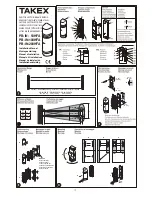
LSS, NMT
SDO, PDO, EMGY
Master
Node-ID = 0
Slave
Node-ID = 1 ... 127
Figure 13: Master/slave model
•
Layer setting services (LSS) are used to set the node ID of the inclination sensor
(
see "Layer setting services (LSS)", page 21
).
•
After this, the inclination sensor can be addressed via the network management
services (NMT) (
see "Network management: NMT", page 24
) and its CANopen
state machine can be switched to the necessary status (Pre-Operational, Opera‐
tional, or Stopped) by the master.
•
In Pre-Operational status, communication and configuration can be carried out via
service data objects (SDO) (
see "Service data objects (SDO)", page 28
ational status, communication is also possible via process data objects (PDO) and
emergency messages (EMGY).
9.1.3
Topology
T-connectors or Y-cables are used to integrate the inclination sensors into the CANopen
trunk cable (the T-connectors are available as accessories). The trunk cable must be
terminated at the end. This is not necessary for the stub cables that are connected to
the sensors.
NOTE
Since TMS/TMM88A and TMS/TMM88D inclination sensors have a female connector
with looped-through CAN bus, they can also be integrated into the trunk cable without
the need for T-connectors or Y-cables.
Stub cables
PLC
Trunk cable
End
Figure 14: Example: Network topology
CANOPEN INTERFACE
9
OPERATING INSTRUCTIONS
| TMS/TMM88, TMS/TMM61
19
8019054/14IT/2019-06-27
| SICK
Subject to change without notice
















































